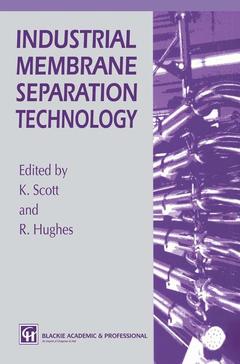Industrial Membrane Separation Technology, 1996
Langue : Anglais
Auteurs : Scott K., Hughes R.

Membrane science and technology is an expanding field and has become a prominent part of many activities within the process industries. It is relatively easy to identify the success stories of membranes such as desali nation and microfiltration and to refer to others as developing areas. This, however, does not do justice to the wide field of separations in which membranes are used. No other 'single' process offers the same potential and versatility as that of membranes. The word separation classically conjures up a model of removing one component or species from a second component, for example a mass transfer process such as distillation. In the field of synthetic membranes, the terminology 'separation' is used in a wider context. A range of separations of the chemical/mass transfer type have developed around the use of membranes including distillation, extraction, absorption, adsorption and stripping, as well as separations of the physical type such as filtration. Synthetic membranes are an integral part of devices for analysis, energy generation and reactors (cells) in the electrochemical industry.
1 Introduction to industrial membrane processes.- 1.1 Introduction.- 1.2 Membrane classification.- 1.3 Conclusions.- 2 Overview of the application of synthetic membrane processes.- 2.1 Classification of membrane separation processes.- 2.2 Membrane processes.- 2.3 Other applications of membranes.- 2.4 Conclusions.- 3 Membrane equipment and plant design.- 3.1 Introduction.- 3.2 Membrane materials.- 3.3 Membrane format and modules.- 3.4 Plant design.- References.- 4 Mass transport and the design of membrane systems.- 4.1 Introduction.- 4.2 Elements of transport phenomena.- 4.3 Fouling and its amelioration.- 4.4 Process design of membrane systems.- References.- 5 Applications in gas and vapour phase separations.- List of symbols.- 5.1 Gas separation.- 5.2 Gas transport through porous membranes.- 5.3 Non-porous membranes.- 5.4 Single-stage permeators and separation factor.- 5.5 Applications of membranes for separation of gases.- 5.6 Operating schemes.- 5.7 Permeator design.- 5.8 Pervaporation.- References.- 6 Applications of cross-flow membrane processes.- 6.1 Introduction.- 6.2 Potable water treatment.- 6.3 Process water treatment.- 6.4 Process applications.- 6.5 Waste water treatment.- 7 Ion-exchange and charge driven processes.- Notation.- 7.1 Electrochemical separators for cells.- 7.2 Membrane and diaphragm materials.- 7.3 Semi-permeable membranes: ion-exchange embranes.- 7.4 Preparation of ion-exchange membranes.- 7.5 Transport in membranes and diaphragms.- 7.6 Membranes in electrolytic cells and fuel cells.- 7.7 Electrodialysis.- 7.8 Electrodialysis cells.- 7.9 Cell stack performance.- 7.10 Polarisation.- 7.11 Membranes and cell design.- 7.12 Applications of electrodialysis.- 7.13 Diffusion dialysis.- 7.14 Salt solution regeneration, recycling and effluent treatment.-7.15 Bipolar membranes.- 7.16 Other membrane processes.- 7.17 Direct membrane cleaning.- 7.18 Electrochemically enhanced cross-flow filtration.- 7.19 Electrochemical membrane gas separations.- 7.20 Electrochemical ion-exchange.- References.- 8 Liquid membranes.- 8.1 Double emulsion membranes.- 8.2 Supported liquid membranes.- 8.3 Membrane contactors.- References.- 9 Membrane reactors.- 9.1 Introduction.- 9.2 Catalytic membrane reactors.- 9.3 Operational aspects of catalytic membrane reactors.- References.
Date de parution : 09-2012
Ouvrage de 305 p.
15.5x23.5 cm
Thème d’Industrial Membrane Separation Technology :
Mots-clés :
electrodialysis; filtration; separation process; transport; ultrafiltration
© 2024 LAVOISIER S.A.S.


